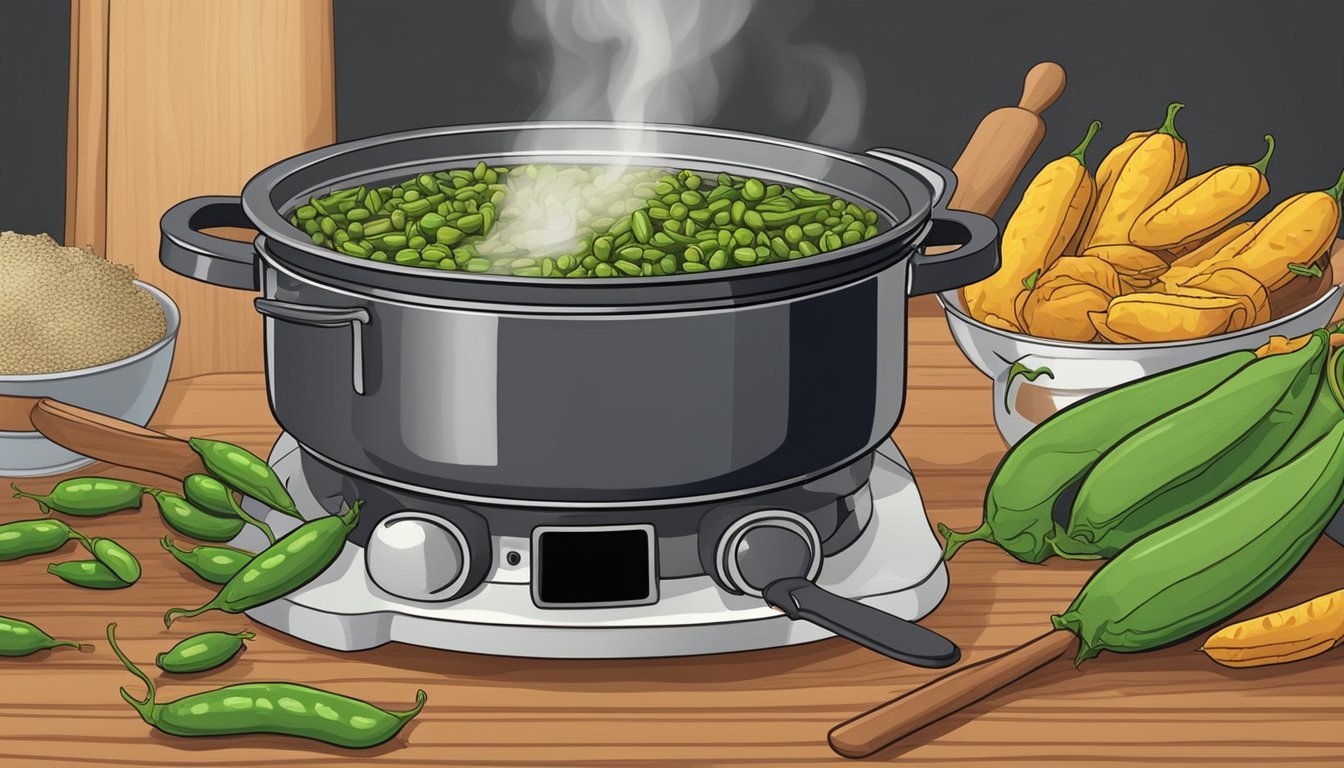Winged Beans Substitutes
Top Alternatives for Cooking
Winged beans, known for their distinct ridges and wing-like leaves, are rich in protein, fiber, and essential vitamins and minerals. If winged beans are unavailable, substitutes like asparagus or green beans can provide similar nutritional benefits and texture in your meals.
For those seeking low-carb alternatives, black soybeans offer a viable option and can be used in various dishes without compromising on protein intake. Lentils are another excellent substitute, offering high levels of fiber, protein, and essential nutrients that make them a staple in health-conscious kitchens.
Winged beans' versatility in soups, stews, and salads can be matched by other legumes like kidney beans or butter beans. These alternatives can help maintain a balanced diet and enhance the flavors of your recipes.
Understanding Winged Beans
Winged beans (Psophocarpus tetragonolobus) are a nutritious vegetable growing in popularity. Known for their distinctive shape and versatility, they are particularly valued in vegetarian and vegan diets for their rich nutrient profile and culinary flexibility.
Nutritional Profile
Winged beans are packed with essential nutrients. They are an excellent source of protein, making them ideal for plant-based diets. Additionally, winged beans provide significant quantities of iron, potassium, magnesium, copper, and zinc.
These beans are also rich in vitamins A, B1, B2, and C. They offer high levels of dietary fiber, promoting digestive health. Low in calories and fat-free, winged beans support a healthy diet without adding excess weight.
Culinary Uses
Winged beans have a unique flavor and texture akin to asparagus and green beans. They can be used in a variety of recipes, including soups, salads, and as a side dish. The young pods are typically the best for cooking.
Cooking times vary but are generally short; steaming or stir-frying preserves their nutrients and crunchiness. Whether included in brothy stews or fresh salads, winged beans adapt well, enhancing both taste and nutritional value.
Common Bean Alternatives
For those seeking substitutes for winged beans, there are several legume and non-legume options available that provide similar nutrition, including high fiber and protein content. These alternatives ensure you get the health benefits you need without compromising your recipes.
Legume Substitutes
Lentils
Lentils are an excellent substitute rich in fiber and protein. They cook quickly and fit well in soups, stews, and salads. Varieties like green, red, and brown lentils offer versatility and are packed with essential vitamins, including iron and B vitamins.
Chickpeas (Garbanzo Beans)
Chickpeas are versatile and can be used in a range of dishes from hummus to salads. High in protein and fiber, they help maintain digestive health and provide a good source of healthy fats.
Black Beans
Black beans are known for their rich fiber content and plant-based protein. They work well in Mexican dishes like tacos or as a meat substitute in burgers. They also contain essential minerals like iron and magnesium.
Pinto Beans
Pinto beans are popular in many Latin American dishes and provide a hearty texture. With high fiber content and significant levels of folate, they support overall nutritional needs.
Navy Beans
Navy beans are smaller and offer a mild flavor, making them ideal for soups and baked dishes. They are a great source of dietary fiber and plant-based protein, beneficial for heart and gut health.
Non-Legume Options
Quinoa
Quinoa stands out as a complete protein, containing all nine essential amino acids. It is also high in fiber and can replace beans in salads, stews, and as a side dish. It cooks quickly and adds a nutty flavor to recipes.
Rice
Rice, particularly brown and wild varieties, can be used as a bean substitute. Although it lacks protein compared to beans, it is rich in fiber and can complement many dishes by providing essential carbohydrates.
Nuts and Seeds
Nuts like almonds and seeds such as chia and flax can add valuable nutrition. They are rich in healthy fats, fiber, and various vitamins and minerals. Incorporate them into salads, cereals, or as ground pastes.
Cauliflower
Cauliflower can be a surprising substitute, especially when grated or mashed. It can add bulk to dishes while keeping them low in calories. Rich in vitamins C and K, it ensures nutritional balance without the heavy carb load of beans.
Special Dietary Considerations
When substituting winged beans, it's crucial to consider specific dietary restrictions. This includes vegan and vegetarian substitutes, as well as gluten-free and allergy-safe options.
Vegan and Vegetarian Substitutes
For those following vegan or vegetarian diets, several plant-based options can replace winged beans. Tofu and tempeh are excellent choices due to their high protein content and versatility.
Edamame is another viable option, providing a similar texture and nutrient profile. Cauliflower can be a creative substitute in certain recipes, offering a mild flavor that blends well. Quinoa also works well in salads and soups, giving a nutty taste and additional protein.
Sunflower seeds can add a crunchy texture and essential fats to dishes. These substitutes ensure that dietary requirements are met without sacrificing flavor or nutrition.
Gluten-Free and Allergy-Safe Options
For those needing gluten-free or allergy-safe alternatives, options such as sorghum and quinoa are ideal. Both grains are naturally gluten-free and can easily replace winged beans in various recipes. They offer a good source of protein and fiber.
Rice and millet are other gluten-free grains that can be used to provide a similar texture. Sunflower seeds and pumpkin seeds are excellent choices for those with nut allergies, providing the necessary crunch and nutrients.
Cauliflower, when prepared appropriately, can also serve as a versatile and allergy-friendly substitute, fitting smoothly into different culinary applications.
Substituting Winged Beans in Recipes
When substituting winged beans in recipes, it’s important to consider both flavor and texture to ensure your dish maintains its intended quality. The following guidelines provide detailed information on how to best achieve these attributes.
Matching Flavors
Winged beans have a slightly nutty flavor that can be challenging to replicate. Cauliflower florets make an excellent substitute due to their mild taste, which adapts well to various spices and seasonings. For recipes like chili or stews, ground meat or mushrooms can also be used to mimic the heartiness of winged beans, providing a similar depth of flavor.
In casseroles or dips, eggplant works well as it absorbs surrounding flavors while adding a subtle sweetness. Be mindful of balancing seasoning, especially in meat dishes, to ensure that the new ingredient integrates smoothly.
Maintaining Texture
The texture of winged beans is crunchy and firm, making texture preservation a key aspect of substitution. In stews and casseroles, cauliflower florets are recommended due to their ability to retain some crunchiness even after cooking. Eggplant, when chopped into bite-sized pieces, offers a tender but firm consistency suitable for dips and sauces.
For meat-based recipes, finely chopped mushrooms can offer a chewy texture similar to that of winged beans. Alternatively, ground meat provides a hearty consistency that works well in chili and stews, ensuring the dish remains satisfying and flavorful.
Cooking Tips for Bean Substitutes
Incorporating bean substitutes like grains, seeds, and vegetables can enhance the texture and flavor of your dishes. Learn how to prepare these alternatives to ensure your meals remain nutritious and delicious.
Preparing Grain and Seed Alternatives
Quinoa is an excellent substitute. It cooks quickly, usually in about 15-20 minutes. Rinse quinoa thoroughly to remove its natural coating, which can be bitter. Use a 2:1 water-to-quinoa ratio for a fluffy texture.
Barley offers a chewy texture. It needs a longer cooking time, approximately 40-50 minutes. Soaking barley overnight can reduce this time, making it more user-friendly.
Seeds like chia and flax can also be mixed with water to form a gel-like consistency, useful in thickening soups and stews. For this, use 1 tablespoon of seeds with 3 tablespoons of water per serving.
Using Vegetable Replacements
Cauliflower rice serves as a low-carb substitute. It requires minimal cooking—lightly sauté for 5-7 minutes. Finely chop or grate cauliflower to achieve the desired consistency.
Zucchini and squash can be spiralized or chopped into cubes. If using them in soups or stews, add them towards the end of cooking to maintain their firmness.
Mushrooms can also serve as a meaty alternative. They bring a unique texture and flavor, especially when sautéed or grilled. They need about 10-15 minutes of cooking. Slicing mushrooms thinly ensures even cooking.
These tips will help you effectively use grain, seed, and vegetable substitutes in place of beans.
Enhancing Bean Substitutes
Elevating the flavor of bean substitutes can be effectively achieved through the clever use of herbs and spices, as well as additional flavorings, to create a satisfying and delicious dish.
Herbs and Spices
Adding herbs and spices to bean substitutes can greatly enhance their flavor. Cumin offers a warm, earthy taste that pairs well with many grains and legumes. Garlic adds a pungent, savory flavor, while rosemary can introduce a fragrant, slightly piney taste.
For those looking to mimic the smoky flavor of some beans, smoked paprika is an ideal choice. Taco seasoning can also be a versatile blend, combining chili powder, cumin, and oregano to create a robust flavor profile that complements many dishes.
Additional Flavorings
Incorporating additional flavorings can further enhance the taste of bean substitutes. Lemon juice brightens and balances flavors, adding a citrusy zest. Soy sauce can provide a rich umami depth, perfect for savory dishes.
Tomato puree or paste contributes a tangy, sweet complexity, particularly in soups and stews. Onion imparts a sweet and sharp essence, which becomes milder upon cooking. These additional flavorings, when combined with grains or legumes, can transform any meal into a flavor-packed experience.
Health and Nutrition Information
Substituting winged beans with other nutrient-rich options can maintain or even enhance nutritional benefits. Key aspects to consider are protein content and fiber levels, which play critical roles in overall health.
Benefits of High-Protein Substitutes
High-protein substitutes like edamame, chickpeas, and black soybeans provide essential amino acids necessary for muscle growth and repair.
Edamame contains 17 grams of protein per cup, offering a substantial protein boost. Chickpeas are not only rich in protein but also include important nutrients such as iron and magnesium that support overall health.
Black soybeans are an excellent replacement; they provide an ample amount of protein along with healthy fats that contribute to heart health. These alternatives are beneficial for those looking to maintain or increase protein intake without sacrificing nutritional quality.
Fiber-Rich Alternatives
Lentils, split peas, and other legumes are excellent fiber-rich substitutes for winged beans. Lentils contain 15.6 grams of fiber per cup, promoting better digestion and gut health.
Split peas are another great option, offering 16.3 grams of fiber per cup. Their high fiber content aids in maintaining healthy blood sugar levels and supports weight management.
Including these fiber-rich alternatives also adds various antioxidants and vitamins to your diet, further contributing to overall well-being. These substitutes help ensure that a robust nutritional profile is maintained even when winged beans are not available.






